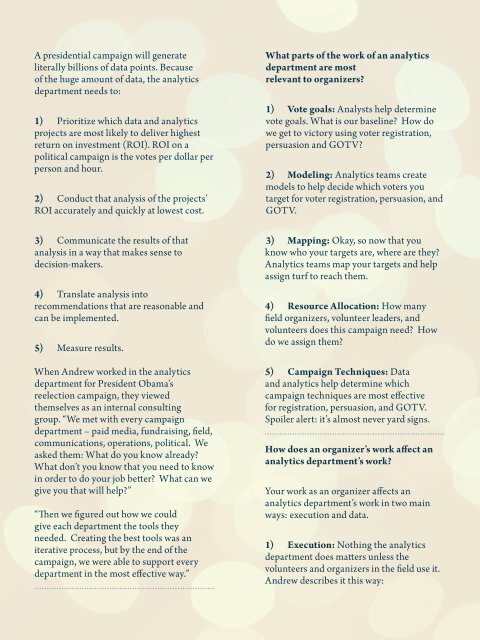63 Magazine - Issue 1
63 Magazine, for progressive political organizers. Issue 1 is all about Inspiration, featuring Marlon Marshall.
63 Magazine, for progressive political organizers. Issue 1 is all about Inspiration, featuring Marlon Marshall.
You also want an ePaper? Increase the reach of your titles
YUMPU automatically turns print PDFs into web optimized ePapers that Google loves.
A presidential campaign will generate<br />
literally billions of data points. Because<br />
of the huge amount of data, the analytics<br />
department needs to:<br />
1) Prioritize which data and analytics<br />
projects are most likely to deliver highest<br />
return on investment (ROI). ROI on a<br />
political campaign is the votes per dollar per<br />
person and hour.<br />
2) Conduct that analysis of the projects’<br />
ROI accurately and quickly at lowest cost.<br />
3) Communicate the results of that<br />
analysis in a way that makes sense to<br />
decision-makers.<br />
4) Translate analysis into<br />
recommendations that are reasonable and<br />
can be implemented.<br />
5) Measure results.<br />
When Andrew worked in the analytics<br />
department for President Obama’s<br />
reelection campaign, they viewed<br />
themselves as an internal consulting<br />
group. “We met with every campaign<br />
department – paid media, fundraising, field,<br />
communications, operations, political. We<br />
asked them: What do you know already?<br />
What don’t you know that you need to know<br />
in order to do your job better? What can we<br />
give you that will help?”<br />
“Then we figured out how we could<br />
give each department the tools they<br />
needed. Creating the best tools was an<br />
iterative process, but by the end of the<br />
campaign, we were able to support every<br />
department in the most effective way.”<br />
What parts of the work of an analytics<br />
department are most<br />
relevant to organizers?<br />
1) Vote goals: Analysts help determine<br />
vote goals. What is our baseline? How do<br />
we get to victory using voter registration,<br />
persuasion and GOTV?<br />
2) Modeling: Analytics teams create<br />
models to help decide which voters you<br />
target for voter registration, persuasion, and<br />
GOTV.<br />
3) Mapping: Okay, so now that you<br />
know who your targets are, where are they?<br />
Analytics teams map your targets and help<br />
assign turf to reach them.<br />
4) Resource Allocation: How many<br />
field organizers, volunteer leaders, and<br />
volunteers does this campaign need? How<br />
do we assign them?<br />
5) Campaign Techniques: Data<br />
and analytics help determine which<br />
campaign techniques are most effective<br />
for registration, persuasion, and GOTV.<br />
Spoiler alert: it’s almost never yard signs.<br />
How does an organizer’s work affect an<br />
analytics department’s work?<br />
Your work as an organizer affects an<br />
analytics department’s work in two main<br />
ways: execution and data.<br />
1) Execution: Nothing the analytics<br />
department does matters unless the<br />
volunteers and organizers in the field use it.<br />
Andrew describes it this way:





